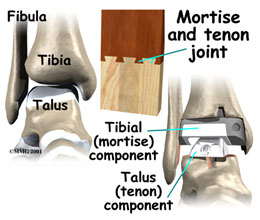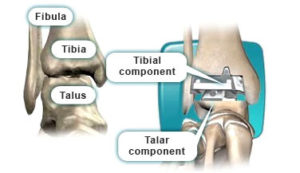 Total ankle replacement is also called ankle arthroplasty or Ankle Joint Replacement. It is a surgical option for patients with arthritis of the ankle. This operation can relieve pain and maintain motion in the arthritic ankle joint. It is an alternative to arthrodesis (ankle fusion) which can relieve pain but eliminates motion in the joint. Although it does not have the same long-term track record of hip or knee replacement shorter-term studies on ankle replacement, look very promising.
Total ankle replacement is also called ankle arthroplasty or Ankle Joint Replacement. It is a surgical option for patients with arthritis of the ankle. This operation can relieve pain and maintain motion in the arthritic ankle joint. It is an alternative to arthrodesis (ankle fusion) which can relieve pain but eliminates motion in the joint. Although it does not have the same long-term track record of hip or knee replacement shorter-term studies on ankle replacement, look very promising.
Types of surgery
Often treatment of ankle arthritis only requires restricting the patient’s activities to things that are not painful and making certain that the shoe is comfortable. In general, a shoe that laces up above the ankle and has a cushioned heel will be more protective than other types of shoes.
Bracing of the ankle is another option. This can be provided by a device known as an ankle lacer. It fits inside the shoe and laces up like an old-fashioned boot. A third option for more significant pain is an AFO which stands for Ankle Foot Orthosis. This is a plastic brace that goes along the back of the leg and the underside of the foot and also fits inside the shoe. This requires a slightly larger than normal shoe size.
Ankle Joint Replacement Surgical options
 Surgical options include arthrodesis and ankle replacement (or total ankle arthroplasty).
Surgical options include arthrodesis and ankle replacement (or total ankle arthroplasty).
Arthrodesis is the connection between the tibia fibula and talus. This operation is excellent for pain relief but sacrifices the up-and-down motion of the foot that generally occurs through the ankle. The talus is permanently fixed to the end of the leg bone.
Ankle replacement is a procedure that has been available for approximately 25 years. However, it has not been as successful as hip and knee replacement surgery. Because the ankle is not as often involved in arthritis there has been less study devoted to this area. Over the last 10 years ankle arthroplasty has been growing in popularity as the implants available for replacement have improved. Current studies indicate about a 90 percent patient satisfaction rate in the first four years after surgery. One anticipated problem in the future may be loosening of this artificial ankle. An orthopedic surgeon should help you make the decision if you might be a candidate.





